Greetings, fellow firewood enthusiast! If you’re looking for better fires and are wondering if kiln-dried firewood is worth it, you’ve come to the right place!
In this guide, we will take you on a journey through the wonderful world of kiln-dried firewood. We’ll show you how it’s made, why it’s awesome, how to store it and more!
Of course, if you want to skip this guide and get right to purchasing some of your own, we can help you with that, too! Please click the link below to visit our product page, where you will learn how to place your order today!
Now that we’ve got that out of the way, let’s get to the guide! Here’s a quick overview of everything we’ll cover below:
- How Kiln-Dried Firewood is Made
- The Benefits of Kiln-Dried Firewood
- The Ideal Moisture Content of Kiln-Dried Firewood
- Kiln-Dried Firewood vs. Seasoned Firewood
- How to Identify Different Types of Firewood
- Determining the Best Firewood to Burn
- Choosing the Best Wood for Your Situation
- How to Measure a Cord of Firewood
- How to Stack Kiln-Dried Firewood
- Where to Store Kiln-Dried Firewood
- What to Do If Your Kiln-Dried Firewood Gets Wet
- Where to Buy Firewood Near Me
- How to Buy Bulk Firewood
- What You Should Know About Transporting Firewood
- How to Build a Fire
- How Long Your Firewood Should Last
- Frequently Asked Questions
Chapter 1: How Kiln-Dried Firewood is Made
Where does kiln-dried firewood come from? Unfortunately, no magical forest produces logs that are perfect for burning. We wish!
The truth is kiln-dried firewood starts the same as all other firewood—as a tree chopped down in the forest. But the magic begins when workers split those logs and cut them to length, removing all substandard pieces. They then take the good pieces and place them into massive kilns.
These kilns create the perfect hot, low-humidity environment to remove moisture from the wood. In only 30 hours at 260 degrees, they can reduce the wood’s moisture content to less than 20%, which is the ideal level for burning.
Many firewood companies use the kiln-drying process because it is much quicker than drying it without a kiln. The kiln also creates a controlled environment for perfect wood production. It’s how the best firewood companies produce a consistently high-quality product all year long.
Chapter 2: The Benefits of Kiln-Dried Firewood
What’s so great about this special wood anyway? We’re glad you asked.
To put it simply, kiln-dried firewood is a luxury brand of firewood. The difference between purchasing it and regular firewood is akin to purchasing a Lexus instead of a Chevy. Sure, the latter car will get you from point A to point B, but the former will make the ride a lot more fun!
And we don’t know about you, but when we purchase firewood, we’re usually looking to have a good time!
What makes kiln-dried firewood so much more enjoyable? Let us count the ways:
- Its low moisture content makes it easier to ignite than standard wood.
- It burns more efficiently to create hotter fires using less wood.
- The kiln-drying process creates wood that is completely free of insects, mildew and fungus.
- Burning kiln-dried wood also produces less creosote and harmful emissions.
- Did we mention that it generates less smoke when burning?
- Plus, it also weighs less than regular seasoned wood because of its low moisture content, making it easier to carry.
- And it’s cleaner to store because it doesn’t shed much bark or debris.
We could go on (as we do in our blog on this topic), but we think you get the point. It’s hard to beat the luxury of wood that’s ready to burn right when you purchase it!
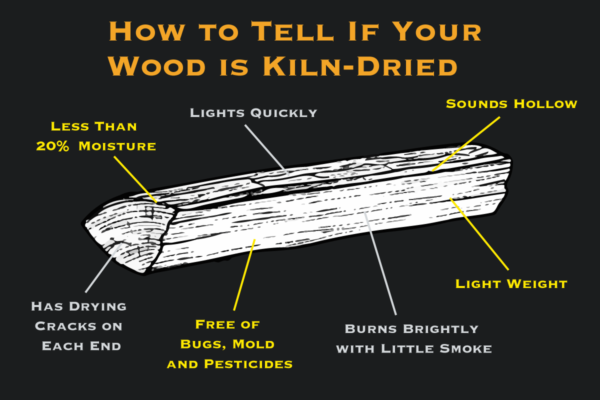
Chapter 3: The Ideal Moisture Content of Kiln-Dried Firewood
Of course, you won’t get all the benefits listed in the previous chapter if the wood isn’t dry enough. Which begs the question: how dry should kiln-dried firewood be?
University studies show that the ideal moisture level for firewood is below 20%. To give you some perspective, freshly cut firewood (a.k.a. green firewood) typically has a moisture level of above 60%.
Kiln-dried firewood sellers measure the moisture content of their wood with a moisture meter. If you want one for yourself, most hardware stores sell these nifty tools for public use.
But what if you don’t own a moisture meter? How can you tell if your wood is dry enough? Here are a few telltale signs:
- The wood will weigh less than a freshly cut piece.
- The pieces will make a hollow sound when hit together. (In contrast, green wood will make a dull thud.)
- There will also be drying cracks on the ends of the wood.
If your wood fails the above tests, then it’s not worth the time you’ll spend trying to light it. Never settle for anything less than kiln-dried wood with a moisture level below 20%. Your friends and family will thank you on a cold winter’s night!
Chapter 4: Kiln-Dried Firewood vs. Seasoned Firewood
There’s a debate raging on the internet about which is better: kiln-dried firewood or seasoned wood. And we wouldn’t be doing our due diligence if we didn’t address it. So here, for your enjoyment, is an overview of why kiln-dried wood is superior to seasoned firewood.
First, let’s define what seasoned firewood is. Seasoned firewood is firewood dried in the natural way (i.e., without a dry kiln). You will often find this type of wood for sale at hardware stores and gas stations around Chicagoland.
There are two problems with seasoning wood that kiln drying solves. First, as you would expect, it takes a long time to dry wood the natural way. A dry kiln speeds up that process significantly and works year-round no matter the level of moisture in the air.
Second, rarely does seasoning wood get the wood below the 20% moisture threshold. On a good day, seasoned wood still contains a moisture level between 20-30%. Kiln-dried wood, on the other hand, is consistently below 20% because of the controlled drying process.
Finally, seasoned wood can sometimes contain many invasive insects, mold and fungus. These pests often infect the wood while it sits out to dry. And they’re no fun to deal with, especially when the bugs get inside your home and the mold and fungus produce dirty and harmful smoke.
The good news is kiln-dried firewood doesn’t contain any of these invasive pests. The super-hot kiln drying process kills them all off so that you can enjoy pristine, high-performing wood.
We think we’ve proved our point: kiln-dried wood clearly wins this fight by a landslide!
Chapter 5: How to Identify Different Types of Firewood
Yeah, all of that kiln-dried stuff is great, but what about all of the different types of wood? Ash, birch, oak, spruce—what do I need to know about them?
Once again, we’re glad you asked!
It’s important to distinguish between the different types of wood because, as you’ll see below, certain woods work better for certain situations.
The best way to distinguish between woods is by looking at their color, texture and grain. Some woods also have a distinct smell.
Here’s a list of some popular woods and their distinguishing features:
- Apple – Light reddish or brownish color with a straight grain and faint sweet odor
- Ash – Light color with a coarse texture and excellent core strength
- Birch – White to light reddish-brown color with a uniform texture and wavy pattern
- Cherry – Rich reddish-color with a uniform, smooth texture
- Hickory – Light to medium brown color with a grain that varies between straight and wavy
- Oak – Very durable with a variety of colors and clearly visible annual rings
- Pecan – Light to medium brown color with a usually straight grain
- Walnut – Heavy wood with irregular grain and a slight odor
To get a better idea of what these species of wood look like, check out the firewood identification chart below.
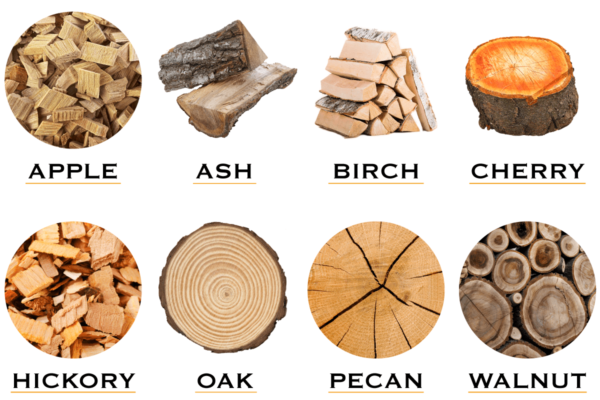
Chapter 6: Determining the Best Firewood to Burn
Of course, knowing what type of wood you’re dealing with is only half the battle. It’s also crucial to identify which kinds of wood burn the best.
The most important characteristic that determines how well a log will burn is if it’s a hardwood or a softwood.
Hardwood species come from trees that lose their leaves annually. These include woods like oak, cherry and hickory. Softwood species, on the other hand, come from evergreen trees. Examples of these are pine, cedar and spruce.
So, which type burns better? Drumroll, please… hardwood! Hardwood burns better because the wood grows more slowly than softwood. As a result, the wood is often denser (thus, the name hardwood).
But which of the hardwood species burns the best? Typically, the species with the highest heat value are apple, oak and hickory. However, as we will see below, the type of wood you should choose will depend on what you’re going to use it for.
Chapter 7: Choosing the Best Wood for Your Situation
It’s time to choose your own firewood adventure! Are you going to winterize your fireplace for a winter full of fires? Or will you venture out into the wilderness for a campfire or safe fire pit under the stars? Of course, you also can’t go wrong with firing up the grill to cook a delicious dish.
Here are some tips for picking the right kiln-dried firewood for each situation:
Best Wood for Fireplace
For an excellent fireplace experience, we recommend kiln-dried oak wood. Oak has an exceptionally long burn time, perfect for a lazy afternoon in. It also produces very little smoke and creosote. The last thing you want is to set off that smoke alarm when you’re trying to get cozy by the fire!
Best for Campfires
Oak is also an excellent choice for an outdoor campfire because of the qualities listed above. However, hickory might be a better choice because of how hot and efficiently it burns! It creates some of the biggest fires, making a bundle of hickory firewood essential for a cool night around the campfire.
Are you worried about mosquitoes plaguing your outdoor fun? An excellent species of firewood for keeping mosquitoes away is piñon wood. Piñon burns exceptionally hot for a softwood species and produces a pleasant pine aroma that mosquitoes simply can’t stand!
Best Firewood for Cooking
Some of the best species for cooking are hickory, cherry and oak. The best choice for you will depend on what type of flavor you want to produce. Hickory adds a classic Texas barbeque flavor when smoking meat; cherry wood produces a light fruity taste; oak creates the perfect amount of smokiness.
Size is also an important factor to consider when looking for kiln-dried cooking wood. Many portable pizza ovens, wood grills and meat smokers work better with wood that is split to six or eight inches than with full-size firewood.
If you’re looking for smaller single species cooking wood, we recommend our friends at Hot Box Cooking Wood. Hot Box delivers boxes of perfectly sized kiln-dried wood throughout the country with free two-day shipping. You can choose from a variety of species, including oak, hickory, cherry, sugar maple and more!
Best Smelling Firewood
If you’re looking for great-smelling firewood, then you really can’t go wrong with any premium wood. Hickory, oak, birch, pine, piñon and cedar all produce that classic campfire smell. But if you’re looking for a uniquely delightful scent, then we recommend cherry wood. As its name indicates, cherry produces a tantalizing fruity aroma perfect for a crackling fire at a classy gathering!
Best Wood for Beautiful Flames
If you’re looking for beautiful flames, then we recommend birch. It produces a unique blue glow that is easy on the eyes.
A close runner-up is cherry. Its flames have more of a purple tint to them and are also relaxing to watch.
Best Firewood to Keep You Warm
Pretty flames and pleasing smells are great and everything, but what about heat? If you’re looking for the warmest fire possible, we recommend oak, which averages 29 BTUs of heat per cord. This is the highest amount of heat produced by any hardwood, followed closely behind by hickory at 28 BTUs per cord.
Best for Protecting the Environment
Any type of kiln-dried firewood is an excellent choice for environmentally conscious firewood enthusiasts. This is because the kiln-drying process removes moisture, mold and pests from the wood, making burning it less hazardous to the environment.
However, the best type of kiln-dried wood for the environment is hickory. Since it burns very hot, it breaks down any harmful compounds into much less hazardous components. Thus, it produces the least emissions of any firewood type.
Chapter 8: How to Measure a Cord of Firewood
One of the trickiest parts of purchasing firewood is understanding the language firewood sellers use. Specifically, we are referring to the term “cord of firewood.” Maybe you’ve heard that term and are not sure what it means. Read on to find out!
A cord is a unit of measurement for firewood. A full cord is the amount of firewood that can fill a space that is 4’ high, 8’ wide and 4’ deep, or 128 cubic feet. However, most companies don’t sell their firewood in full cords. Instead, they use a measurement called a face cord.
The difference between a full cord and a face cord is the depth measurement. Whereas a full cord will include multiple firewood stacks to fill out the four-foot depth requirement, the face cord only includes one stack of firewood. So, the depth of a face cord will depend on how long the individual pieces of firewood are. This length often varies from company to company.
Because of this variation, you should be careful when shopping for firewood. One company’s face cord may not equal another’s. After all, one company may chop its wood shorter than the other. Plus, there is no officially recognized measurement for a face cord, making it very easy for shady companies to rip you off.
For this reason, you should only trust firewood companies that clearly state how they measure a face cord directly on their website. For example, at Lumberjacks, we explicitly define our face cord as measuring exactly 4’ high x 8’ wide x 16” deep. We do this so that our customers know exactly how much wood they’ll be getting and won’t be shortchanged.
Chapter 9: How to Stack Kiln-Dried Firewood
You may be surprised to learn that there is a correct way to stack kiln-dried firewood. After all, what difference could the way you stack it make? The answer is a HUGE difference! If you stack the wood willy-nilly, or worse, leave it in a heap in the grass, you run the risk of exposing the wood to too much moisture.
Remember, kiln-dried wood already comes as dry as it needs to be. Keeping it that way is the name of the game.
Here are some best practices to follow when stacking your wood:
- Keep the Stack Off the Ground – Stacking it on a pallet or wood beams will keep it from getting wet.
- Avoid Placing Your Stack Against a Wall or Fence – Keep a few feet of space between the stack and wall to allow for airflow.
- Stack the Wood Loosely – Keeping space between the pieces will also allow for airflow.
These are just a few of the important practices to keep in mind for wood stacking. There’s more where that came from if you want to become a stacking master!
Of course, if you worry about improperly stacking your wood, you can also let the professionals handle it for you. Many firewood companies offer to stack the wood themselves. Just make sure they are not offering to stack it for you so that they can give you less wood than you ordered! The best companies won’t insist on stacking their wood because they have nothing to hide.
Get More Helpful Firewood Content Delivered to Your Email
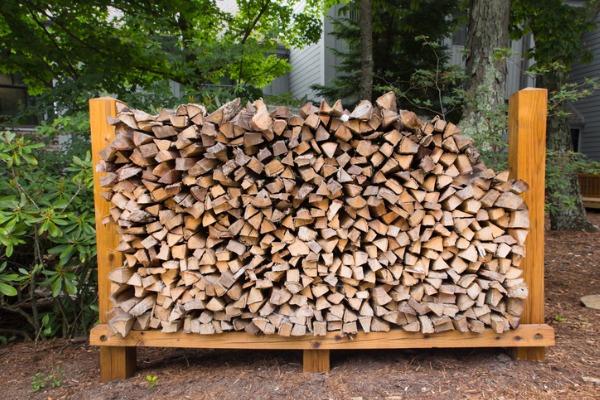
Chapter 10: Where to Store Kiln-Dried Firewood
Now that you know how to stack it, it’s time to find where to store your wood! Let’s go over some of the best practices for storing firewood.
The nice thing about kiln-dried firewood is it comes completely free of mold and insects. Because of this, it’s perfectly fine to store the wood inside the home. However, as we will see, storing indoors only makes sense under the right conditions.
You should only store your wood inside if you have a spacious spot with enough airflow and low enough humidity for the wood to thrive. Usually, a garage, basement or storage shed will meet these requirements.
If you don’t have indoor space, it’s also okay to stack the wood outside. Just keep in mind the stacking principles we discussed above.
You should also consider a way to protect the logs from the rain. A standard wooden log store is great for this. You could also use a tarp. Just be sure that you don’t cover the wood too tightly lest you restrict the airflow.
Chapter 11: What to Do If Your Kiln-Dried Wood Gets Wet
If you follow the best practices discussed in chapters 9 and 10, then you should be successful in keeping your kiln-dried firewood dry. But what happens if the firewood gets wet? The key is not to panic! Instead, by following these best practices, you can hopefully salvage your wet wood and get it back to prime burning condition.
The first step is to determine how wet the wood got. If you store the firewood outside, it will inevitably encounter some moisture. But a little dampness is nothing to worry about. The wind and sun should have no trouble getting rid of that moisture if the wood is stacked properly in an area with plenty of sun exposure and airflow.
However, if the firewood won’t burn because it’s taken on a considerable amount of water from a recent rainstorm, then you should follow these steps to save your firewood:
1. Examine the Wood for Rot
The wood will only begin to rot if it takes on a lot of water and then sits in those moist conditions for a long time. So, the sooner you can attend to your wood after it gets wet, the better. If you find any rotten pieces, get rid of them.
2. Separate the Wet Pieces from the Dry Ones
You can use a moisture meter to determine which ones are over and under 20%.
3. Stack the Wet Logs and Let Them Dry for a Week
Get the wood out of a moist environment as soon as possible. You may want to stack the wet wood in an indoor storage shed to ensure it stays out of the rain. If the weather looks clear for the next few days, you can also stack it outside. The more sun and wind the wet stack encounters, the better.
The kiln-dried firewood should be back to the ideal level of dryness after about a week of drying. Once it is, you can add it back to your regular pile of wood.
You may also want to bring the wood indoors a few days before you plan on burning it. This way, the firewood will have a chance to dry out a little more beforehand.
Chapter 12: Where to Buy Firewood Near Me
You’ve almost made it through our crash course! One of the last pieces of the puzzle is figuring out where to get your kiln-dried wood.
So, how do you know if a firewood supplier is worth your business? There are a few key questions to ask to avoid purchasing wood you’ll regret:
- Are they selling their wood at a suspiciously low price?
- Does the wood have a high moisture content?
- Is the wood unsplit, moldy or muddy?
- Do they sell softwood species like pine and cedar instead of better-burning hardwood species like oak and hickory?
- Does the supplier insist on stacking the wood for you?
- Do they use crisscross stacking methods when they stack their wood?
- Is the seller unable to deliver the wood to your home?
If you answer yes to any of these questions, then the company is probably not worth buying from. All these practices are red flags that indicate the seller is likely trying to rip you off.
Don’t buy from shady firewood suppliers. Instead, look for a company that offers quality wood at a fair price. The business should be transparent about how they produce their wood. They should also have no problem with you asking to inspect the wood to make sure you got the right amount.
Above all, always go with a company you can trust! Here at Lumberjacks, we provide the most trustworthy firewood delivery in the Chicago region. We’d be honored to serve you, too.
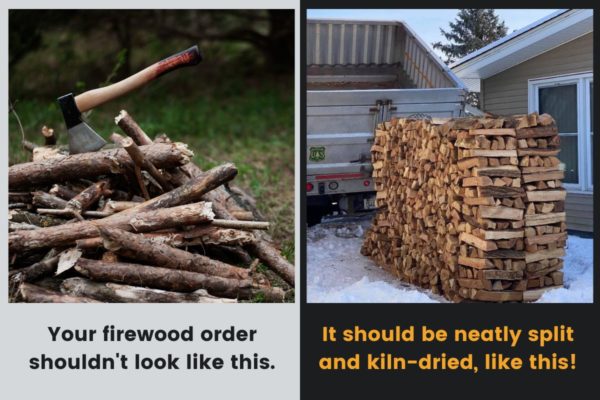
Chapter 13: How to Buy Bulk Firewood
Buying in bulk is a great decision to save money. However, you’ll want to follow these best practices for buying in bulk to ensure you don’t wind up with a bunch of awful wood.
First, only buy from a trustworthy seller with a good track record for quality service. Ideally, that company should also sell kiln-dried firewood to give you the most benefits for your buck.
Next, you’ll want to determine how much firewood you’ll need and plan where you’ll store it. A full cord of wood typically lasts a full winter for an average household. But you may need more or less depending on how much wood you plan to use per week. The company you’re buying from should be able to help you estimate this.
After this, you’ll want to decide if you should pick up your wood or have it delivered. And once you have the wood at your home, you should stack it yourself to make sure you received as much as you ordered.
If your bulk order contains kiln-dried wood, you can use the wood more conservatively than you would regular wood. This is because kiln-dried firewood can produce hotter fires with less wood. Therefore, your bulk order should last you longer with kiln-dried wood.
Chapter 14: What You Need to Know About Transporting Firewood
One of the trickiest things about buying firewood is all the restrictions that can come with transporting it. We hear about this issue a lot here at Lumberjacks because we serve the Northern Illinois and Southern Wisconsin regions. And there are a lot of questions surrounding what type of wood it’s okay to transport across the state line.
If you purchase traditionally seasoned firewood, then you should know that the state transport restrictions are quite strict. For example, the State of Illinois is under quarantine for the Emerald Ash Borer, which can kill trees if it spreads. So, it’s against regulations to move potentially infested wood out of Illinois.
Similarly, Wisconsin has restrictions in place against transporting firewood more than 10 miles because of concerns about spongy moth infestation. Like the emerald ash borer, the spongy moth can also kill certain species of trees when it invades them.
The good news is that there are safe ways around these firewood transport restrictions. The best way is to purchase USDA-certified firewood that has been heat-treated and kiln-dried. To get this certification, wood must be heat treated for at least an hour at 140°F or more.
At Lumberjacks, we go well above this requirement by baking the wood at 260°F for 30 hours. So, you can rest assured that you can transport our wood anywhere without bringing any unwelcome pests along with you!
Chapter 15: How to Build a Fire
Building a fire with kiln-dried firewood is easy! All you will need are three other items to use along with your wood:
- Tinder – small, easily combustible materials you can use to get your fire going (some options for this include dried leaves, pine needles, dryer lint, cotton balls and newspaper)
- Kindling – smaller pieces of wood that will light easily and burn long enough to ignite the larger firewood pieces (pieces of birch or cedar are great for this)
- Firestarter – a lighter or match to ignite the tinder and kindling
Popular Methods for Starting a Fire
Once you have these four ingredients, you’re ready to start your fire. There are many different techniques you can use to do this. Probably the most well-known technique is the tepee method, which involves building a tepee around the tinder and kindling with the firewood.
While the tepee method works, it also requires a lot of maintenance to keep the fire going. For this reason, we prefer a lower maintenance technique called the log cabin method. This method is also better for getting a larger fire going quicker.
Building a Fire with the Log Cabin Method
You can build a fire using the log cabin method by following these six simple steps:
- Start with two pieces of firewood positioned parallel to each other with a little space in between.
- Stack two more pieces on top of those pieces and at a perpendicular angle to them.
- You should now have a square of space in between your four-log structure. Place some tinder and kindling in this space so that it’s elevated slightly off the ground.
- Use your lighter or match to ignite the tinder and kindling in the space beneath it.
- The fire should get going after a few minutes. You can blow slightly at the base of the fire to help it along.
- Continue adding firewood pieces slowly to continue building your log cabin structure. Six to eight pieces of kiln-dried firewood should be enough to create a large fire.
By following these steps, you will have an enjoyable fire going in no time. Just be sure to practice fire safety techniques. This includes keeping a bucket of water and a shovel handy when building a campfire and never leaving the fire unattended.

Chapter 16: How Long Your Firewood Should Last
We’re guessing you want your bulk order of firewood to last for as long as possible. The good news is kiln-dried wood has an incredibly long lifespan when properly stacked and stored. The Chimney Safety Institute of America estimates that such firewood will last 3-4 years before it’s not good to burn anymore. And some experts claim it could last even longer!
Tips for Making Your Firewood Last
So, if you want to get the most longevity out of your wood, be sure to follow the stacking and storage tips we outlined above in chapters 9-11. Beyond this, there are some other external factors to be aware of that will affect the lifespan of your wood. They are the species of your wood and the climate where you live.
Some firewood species last longer than others. The exact lifespan will vary from species to species, but the overall rule of thumb is this: hardwood lasts longer than softwood. So, if you’re storing a cord of cedar, it’s going to go bad sooner than a cord of oak.
Another factor to keep in mind is the climate in your region, especially if you store your wood outdoors. Firewood will last the longest in a dry region with low humidity.
Unfortunately for us here at Lumberjacks, we live in the wet and muggy Northern Illinois region. All the extra moisture in the air puts the wood at risk of getting moldy and decomposing sooner than it would elsewhere. Therefore, we encourage our customers to store their kiln-dried firewood indoors whenever possible.
Signs Your Wood Has Gone Bad
Of course, nothing lasts forever in this world, including firewood. So, if you’ve had your wood for multiple years, you’ll want to keep an eye out for signs it’s no longer good to burn. Here are a few red flags to look for:
- Logs no longer feel solid inside and you can easily crack a piece in two
- Bark begins to soften around the edges
- Wood crumbles into small granules in your hand when you pick it up
These are all signs of the natural decay all wood goes through over time. Old, decaying wood produces weak fires and a lot of dirty smoke when it burns. So, when it gets to this point, you’re better off getting some new wood and letting the old logs rest in peace.
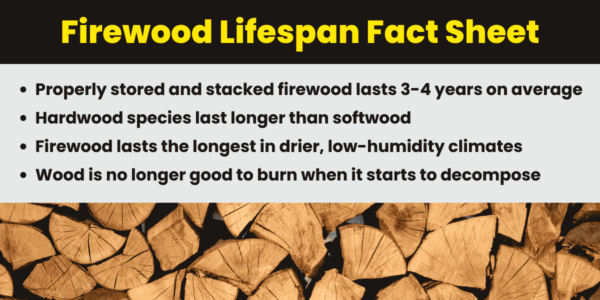
Chapter 17: Frequently Asked Questions
We’ve covered a lot of ground in this guide, but there are still more questions to answer! So, keep reading to find our responses to some of the most common firewood queries.
Is kiln-dried firewood good?
The answer to this question depends on what you mean by good. If you’re fine with buying cheap wood that won’t burn very well, then kiln-dried firewood is not for you. But if you want to enjoy a luxurious fire-making experience from start to finish, then kiln-dried firewood isn’t just a good choice for you; it’s the best! Because it always comes at an optimal moisture content, kiln-dried firewood ignites easier, burns hotter and produces less dirty smoke than any other firewood on the market.
Why does firewood pop and crackle?
Firewood pops and crackles when it contains a lot of water, sap and/or resin. The fire causes these liquids to expand and turn into steam. These pockets of steam get trapped in the wood and continue to expand until they release into the air with a popping sound. This is what’s happening when you hear those pops and see those sparks in your fire.
Why won’t my firewood light or burn?
The most likely reason you can’t get your fire lit or keep it going is that it contains too much moisture. When wood has a moisture content of over 20% it doesn’t perform nearly as well as wood under the 20% threshold. The best wood drying method for ensuring wood has less than 20% moisture is kiln drying. So, we recommend getting kiln-dried firewood for a better burning experience.
Why does firewood smoke?
The amount of smoke firewood produces directly correlates to the amount of moisture in the wood. The higher the moisture content of the wood, the more smoke it will produce. The optimal moisture content for a minimal amount of smoke is below 20%. Only kiln-dried firewood consistently achieves this optimal level of moisture for the perfect amount of smoke.
How much firewood is in a rick?
We can’t tell you exactly how much firewood is in a rick because that can vary from seller to seller. What we can tell you is a rick describes a stack of firewood that is 4’ high by 8’ wide. What varies is the depth of the stack.
Some firewood sellers use the term rick to describe a full cord of firewood, which is 4’ deep for a total of 128 cubic feet of firewood. However, when others say rick, they mean a face cord, which is only one row of firewood deep. How deep that is will depend on how long the seller cuts its pieces, which is often somewhere between 12-18 inches.
So, if you encounter a firewood supplier that sells its firewood by the rick, make sure you get the exact measurements the business uses. This way you’ll know exactly how much firewood you’re getting.
How can you tell good firewood?
Good firewood will have these four characteristics:
- Moisture content below 20% (you can check this with a moisture meter)
- Neatly split pieces with no mold or mud visible
- Cracked ends on the pieces to indicate thorough drying
- Pieces make a hollow sound when hit together
Beyond taking these steps to inspect the wood, you should also make sure you’re buying from a dealer with a good reputation. You can check this by looking at the company’s online reviews and asking around to see if your friends and family had a good experience with them.
How long does a cord of wood last?
A full cord contains 128 cubic feet of firewood. This large amount of wood should be enough to last you between 2-4 months, depending on how often you use firewood. If firewood is your main fuel source for heating your home, then you will likely have to get more wood after two months or sooner.
Can you burn fresh cut wood?
You can burn fresh cut wood, but we wouldn’t recommend it. The wood will contain a lot of moisture, which will make it difficult to ignite, and the fire will probably fizzle out sooner than you’d like. It will also produce a lot of dirty smoke and creosote that will sting your eyes and could harm your health and the environment.
Instead, we’d recommend burning kiln-dried wood, which starts easier and burns hotter and cleaner for a much more enjoyable experience.
Does kiln-dried firewood have bugs?
No! The extremely hot temperatures inside the kiln kill off all insects, mold and fungus during the drying process.
Does kiln-dried firewood have creosote?
Because it contains less than 20% moisture, kiln-dried firewood produces very little smoke and creosote.
Is kiln-dried firewood expensive?
Kiln-dried firewood typically costs more than traditional seasoned firewood but for good reason. The extra steps in the drying process require additional production costs. But these costs are well worth it for the lower-moisture wood they consistently produce. So, you will pay more when you purchase kiln-dried firewood, but you’ll be paying for an easier and more enjoyable fire-making experience.
Congratulations, You Passed the Course!
Now that you’re an expert on kiln-dried firewood, it’s time to celebrate by burning some of your own! We’d be happy to supply it for you.
At Lumberjacks, we produce premium kiln-dried firewood for cooking, camping or relaxing by the fireplace. We also offer local firewood delivery throughout the Northern Illinois and Southern Wisconsin regions.









